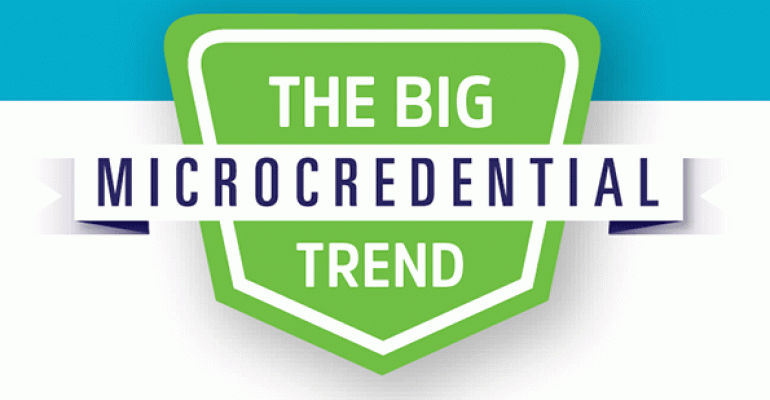 MeetingsNet recently caught up with Tracy Petrillo, CAE, chief learning officer at EDUCAUSE, a nonprofit association for higher education IT leaders, which provides digital badges to members completing some of its educational offerings. Petrillo, whose doctorate in educational leadership and management included a research emphasis related to credentialing, certification value, and leadership development, is cautiously evangelistic about the role of microcredentialing as a complement to formal-assessment credentialing models.
MeetingsNet recently caught up with Tracy Petrillo, CAE, chief learning officer at EDUCAUSE, a nonprofit association for higher education IT leaders, which provides digital badges to members completing some of its educational offerings. Petrillo, whose doctorate in educational leadership and management included a research emphasis related to credentialing, certification value, and leadership development, is cautiously evangelistic about the role of microcredentialing as a complement to formal-assessment credentialing models.
“How people get information has permanently changed,” she says. “If associations, organizations, and meeting planners don’t adapt to that quickly, if we put information behind firewalls and we wait once a year to release it at an annual conference, we’re going to lose members.”
MeetingsNet: How do digital badges work?

Petrillo: An organization, company, or individual awards a digital badge to recognize that someone has demonstrated that they have mastered a skill or completed a project. The issuer sets the criteria the learner has to meet to earn the badge, and verifies that the learner did in fact meet those criteria, before issuing the badge. The learner can put what they’ve earned in a portfolio-style repository called a digital badge “backpack” and can share it on social media or other websites. Each badge links back to the issuer’s metadata records, including who issued the badge, what the criteria were for earning it, and what the badge signifies.
MN: Why do you believe microcredentialing has a place in adult education today?
Petrillo: Adults have a lot of fear around taking tests—no one wants to say they took the Certified Meeting Professional exam and failed. Microlearning lets people explore their interests, find incremental pieces of learning that they need to apply to their jobs very quickly, and then build a comfort level with the content as they build confidence toward taking a formal assessment certification exam or college course. Digital badges provide recognition of that learning. People want to say, “Hey, see that I’m trying to learn something new? Here’s something I can show my peers and my boss when I apply for a new job when I don’t have the time or money to get a new degree.”
Digital badges also help organizations identify new competency areas that are not yet covered in formal educational programs—you see this a lot in the technology area, where someone can earn a digital badge for competency in a specific software version. Also, associations that may not have the time and money invested in a defined formal-assessment credentialing program can define the top five or 10 competencies for their profession, then develop education and microcredentials for each competency.
MN: I could see where there could be some resistance to the idea of microcredentialing, especially from organizations that provide the formal-assessment certifications and degrees. Some might worry that learners—and employers—would confuse earning a badge with earning a certification or degree, rather than being a stepping-stone toward that goal. Others might worry that it opens the door to “badge mills” that just crank out microcredentials that don’t represent real learning or increased competency.
Petrillo: It’s a rapid change, and we’re not used to changing our learning models, or our conference formats, or how we do standardized assessments for certifications within our professions. But there are associations that are doing it.
This is a quick-evolving space, and a lot of the responsibility for how credible the microcredential is falls on the issuer. I’ve seen some badges that aren’t so credible, and I’ve seen some organizations cropping up just to monetize this. It’s up to the issuer to build credibility, to show that its microcredentialing program is helping people step up in the profession and is inspiring people to learn.
MN: Are there any drawbacks to offering digital badges?
Petrillo: Right now there’s no standardization, so it can be hard to determine the value of a microcredential. Again, so much of that value is going to be the responsibility of the issuer. We’re sort of in the mud right now, where people could have a patchwork quilt of badges and you don’t know what they all mean. There are organizations, such as a group called Connecting Credentials, that are trying to bring together all the educational facets, from K-12, higher education, corporate- and nonprofit-provided education, and even the federal Department of Education, to create a pathway through the hierarchy of credentials that people can follow throughout their careers, from the degree at the top, then the highly assessed valid credentialing program, and now these microcredentials below that that people can use throughout their careers to demonstrate competencies.
Also, if an organization serves a profession that’s changing quickly, they have to assess what their members’ jobs are going to look like in three years or five years or 10 years, and find ways to get them the skills they need as their jobs evolve. There’s a lot of forecasting that has to be done—it can’t be based on doing the same old, easy thing year after year.
It’s exciting, but it’s scary, because it’s no longer a static learning system. At EDUCAUSE, we assess the data each year to determine which badges we’re going to continue to do, and what new focuses we need to add. Over the three years we’ve been offering digital badges, our badge constellation continues to evolve.





